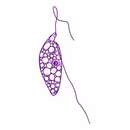Description of Cruzella marina
provided by BioPedia
Cells metabolic, about 27.5 microns, spindle-shaped or oval, slightly compressed on the sides, with sharp-pointed posterior end, when anterior end is terminated by a long snout. The anterior flagellum is shorter than the trailing flagellum, it is equal to the body length and it emanates from the end of the snout. The trailing flagellum emanates just below the snout and is twice the body length. The contractile vacuole not described. Nuclues in the centre.
Description of Cruzella marina
provided by BioPedia
Cells isodiametric, 5-12 microns in diameter excluding filopodia, up to almost 100 microns with filopodia, embedded in mucilage, forming gelatinous growths or free-living. Plasmodial growths rare. Chloroplast irregularly strap-shaped with a central more or less spherical pyrenoid traversed and divided into two by a sinuous slit-like invagination of the plastid envelope. A single nucleus, central in position, nuclear envelope not confluent with plastid ER. Two centrioles immersed deep in the cell, one very short, near a papilla on the nucleus. A single Golgi body against the nucleus with one edge near the centriole pair. Numerous radially arranged leucosin vesicles between the plastid and the cell membrane and scattered lipoidal droplets. Reproduction by division and zoospore formation; cysts unknown. Motile flagellated cells elongate to fusiform, (7)-11-(14) x (2.5)-4-(5) microns, uniflagellate, second flagellum reduced to a short non-functional basal body. Golgi body at posterior end of pyriform nucleus at opposite pole to flagellum. Chloroplast central, eyespot absent.
Description of Cruzella marina
provided by BioPedia
Synonym of Rhynchomonas nasuta
Description of Cruzella marina
provided by BioPedia
Cells are about 5 - 6.5 microns long with a pedicel and a thin lorica that have a short neck at the anterior end. The lorica is ovoid with a slightly pointed posterior end which is connected to the pedicel (~ 2 times the cell length). The cells fill out the posterior part of the lorica. The thickened flagellum is about 1.5 times the length of the cell and is surrounded by the pseudopodial tentacles. The lorica attaches to the substrate by the pedicel. Relatively rare.
Description of Cruzella marina
provided by BioPedia
Flexible cell about 27.4 microns with one anterior flagellum, never swims only glides slowly with the flagellum directed to the anterior; advances stops, squirms and move forwards in a different direction.
Description of Cruzella marina
provided by BioPedia
This heliozoan-like organism is almost spherical and most cells measured between 15 and 20 microns in diameter. The spherical nucleus is situated towards one side adjacent to a depression in the cell surface, from the bottom of which either two or four flagella arise. Cells with four flagella might represent early division stages, but there was no correlation between the number of flagella and cell diameter. About twenty axopodia with extrusomes radiate from the cell. The cell are packed with spherical food vacuoles containing bacteria and the surrounding cytoplasm is filled with rod-shaped (~ 1 microns) organelles or endosymbiotic bacteria. The cells are capable of absorbing the axopodia and of transforming into a slug-like flagellated form.
Description of Cruzella marina
provided by BioPedia
Cells are 9 to 30 microns long, are broadly pyriform with an apical point. The ventral side consists of a wide groove which terminates near the posterior end in a discrete ingestion apparatus. Four flagella insert at the head of a groove in a cruciate pattern: one directed anteriorly, one posteriorly, one leftward and one rightward. The anterior and posterior flagella are one and a half to three times the length of the cell. The anterior flagellum inserts almost apically. It is substantially thickened at its base but gradually tapers to a conventional thickness. The proximal portion of the posterior flagellum usually beats within the groove with wide amplitude, short wavelength waves and two broad vanes may sometimes be discerned. The flagellum may appear attached to the posterior margin of the groove. The subequal lateral flagella are one to two times the length of the cell and are of a normal thickness. The nucleus is located anteriorly, is large, ovoid to pyriform, and contains a conspicuous, irregularly shaped nucleolus. The cell surface sometimes appears dimpled with the light microscope. Captured bacteria collect in posteriorly located food vacuoles. Remains were occasionally observed being expelled from the posterior end. Irregular threads or processes may also form posteriorly. A posterior contractile vacuole is present in cells from freshwater sites. The cells usually swim in relatively straight lines with a slow rotation and with the anterior flagellum directed anteriorly. This flagellum may also be directed ventro-posteriorly, causing motion in a more curved path. The cells may attach to the substrate by the posterior flagellum or by posterior cytoplasmic strands. Ultrastructural studies of the freshwater isolate demonstrate that the cells lack mitochondria, and confirm the presence of two opposed, very broad vanes on the posterior flagellum.

